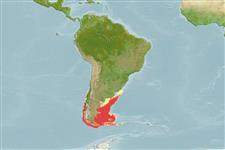Issue
This species is synonym of Macruronus novaezelandiae (Hector, 1871) in Eschmeyer (CofF ver. Jan. 2012: Ref. 89336). Waiting for more confirmation. Please send references or more studies are needed.
Environment: milieu / climate zone / depth range / distribution range
Ecologia
marino benthopelagico; oceanodromo (Ref. 51243); distribuzione batimetrica 30 - 500 m (Ref. 1371). Subtropical; 34°S - 60°S, 79°W - 52°W (Ref. 1371)
Southeast Pacific and Southwest Atlantic: off southern Chile and Argentina.
Length at first maturity / Size / Peso / Age
Maturity: Lm ?, range 54 - ? cm
Max length : 115 cm TL maschio/sesso non determinato; (Ref. 7063); common length : 80.0 cm TL maschio/sesso non determinato; (Ref. 1371); peso massimo pubblicato: 5.0 kg (Ref. 1371); Età massima riportata: 19 anni (Ref. 122851)
Short description
Chiavi di identificazione | Morfologia | Morfometria
Spine dorsali (totale) : 1; Raggi dorsali molli (totale) : 100 - 113; Spine anali: 0; Raggi anali molli: 83 - 90. Dorsal part of body purplish blue, belly silvery with a slight bluish tinge; small melanophores scattered on fin membrane of dorsal and anal fins; inside of mouth blackish (Ref. 1371).
Schooling species which are concentrated on the outer part of the continental shelf (Ref. 1371). Feeds mainly on fish (herring, anchovies, lantern fishes), also on mysids, cephalopods, euphausiids and amphipods (Ref. 1371). Migrates southward in spring and summer and northward in winter (Ref. 1371). Utilized fresh, frozen and for fishmeal (Ref. 1371).
Life cycle and mating behavior
Maturità | Riproduzione | Deposizione | Uova | Fecundity | Larve
Cohen, D.M., T. Inada, T. Iwamoto and N. Scialabba, 1990. FAO species catalogue. Vol. 10. Gadiform fishes of the world (Order Gadiformes). An annotated and illustrated catalogue of cods, hakes, grenadiers and other gadiform fishes known to date. FAO Fish. Synop. 125(10). Rome: FAO. 442 p. (Ref. 1371)
IUCN Red List Status (Ref. 130435: Version 2024-1)
Threat to humans
Harmless
Human uses
Pesca: elevato interesse commerciale
Strumenti
Special reports
Download XML
Fonti Internet
Estimates based on models
Preferred temperature (Ref.
123201): 4.5 - 9.7, mean 6.5 °C (based on 311 cells).
Phylogenetic diversity index (Ref.
82804): PD
50 = 0.5625 [Uniqueness, from 0.5 = low to 2.0 = high].
Bayesian length-weight: a=0.00407 (0.00228 - 0.00729), b=2.97 (2.80 - 3.14), in cm total length, based on LWR estimates for this species & (Sub)family-body (Ref.
93245).
Trophic level (Ref.
69278): 3.8 ±0.55 se; based on food items.
Resilienza (Ref.
120179): Basso, tempo minimo di raddoppiamento della popolazione 4.5 - 14 anni (K=0.09-0.1).
Prior r = 0.28, 95% CL = 0.18 - 0.42, Based on 1 data-limited stock assessment.
Fishing Vulnerability (Ref.
59153): Moderate vulnerability (41 of 100).
Climate Vulnerability (Ref.
125649): High to very high vulnerability (69 of 100).
Nutrients (Ref.
124155): Calcium = 35.8 [16.1, 79.9] mg/100g; Iron = 0.788 [0.361, 1.658] mg/100g; Protein = 17.5 [15.2, 19.7] %; Omega3 = 0.189 [0.091, 0.377] g/100g; Selenium = 60.1 [27.6, 133.1] μg/100g; VitaminA = 12.4 [3.5, 43.2] μg/100g; Zinc = 0.502 [0.326, 0.773] mg/100g (wet weight); based on
nutrient studies.
